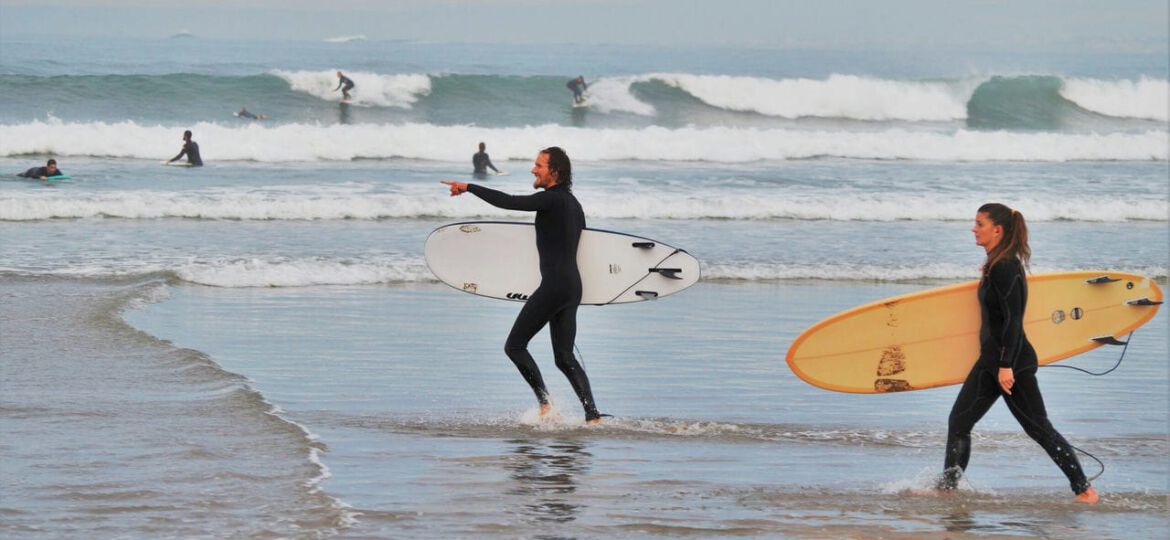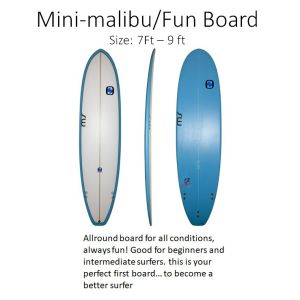
The difference between a softboard and hardboard
The choice between a softboard or a hardboard depends on your surfing experience, personal preference, and the type of waves you plan to ride. Here is some more information about soft boards and hard boards.
Softboard
Softboards are ideal for beginner surfers as they are more forgiving and provide better stability while learning to paddle and stand up. Also good to practice the first turns. Softboards are generally made with a foam core and a soft outer layer, making them less likely to cause injuries and ideal for practicing tricks and turns. Also a softboard is harder to damage then a hardboard, and easy to fix with silicone glue or hot-glue.
Softboards do not perform well in bigger or more powerful waves.
If you just started surfing and you don’t feel that safe yet, go for a softboard. If you only surf a few times per year go for a softboard. Also you can easily lend it out to friends. The softboard is the perfect first board. When you feel you have outgrown the board you can sell it easy and buy a hardboard.
Hardboard
Hardboards are typically preferred by more experienced surfers as they offer more control and maneuverability. Hardboards are generally faster in the water and perform better in larger and more powerful waves. Hardboards can be made from a variety of materials, such as fiberglass, polyester or epoxy. Hardboards are available in different shapes and sizes. For beginners a Mini Malibu is a good option. More experienced surfers tend to go for a longboard, shortboard or fish.
Be careful surfing a hardboard, and always protect your head while falling and coming up to the surface.
If you damage your board, it has to be repaired as fast as possible. A repair is done with epoxy or polyester, if you don’t have experience with repairs. Let it be repaired professionally or watch some YouTube video’s
check my Instagram post for more information!
Surfboard Size
Choosing the proper surfboard size depends on several factors, such as your skill level, weight, height, and the type of waves you plan to ride. Here are some general guidelines to consider:
- A longer board is easier to paddle and provides more stability, making it a great option for beginners or surfers trying to catch smaller waves.
- A shorter board offers more maneuverability and is better for more experienced surfers who want to ride bigger waves or perform tricks.
- Ideally, your surfboard should be 6-12 inches taller than your height and have a width that allows you to comfortably stay balanced while paddling and riding.
- Keep in mind that personal preference is also a factor when choosing a surfboard. It’s recommended to try out different sizes and shapes to determine what works best for you.
Conclusion
Choosing between a softboard or hardboard is not so easy. It comes down to personal preference, how much you go surfing and your skill level. Beginners may find that starting with a softboard allows them to learn and progress with greater stability and safety, while more experienced surfers may prefer the control and speed of a hardboard in larger, more challenging waves.
The size of the board has impact on how easy you can take a wave or make a turn. most people tent to buy a board that is too small. and struggle a lot with peddling, timing and balance. my advice is to try out some boards at your local surfschool before you buy.






I have been surfing on-line greater than 3 hours these days, but I by no means found any attention-grabbing article like yours.
It’s beautiful worth sufficient for me. In my view, if all website owners
and bloggers made good content as you did, the internet will likely be much more
helpful than ever before.
Rikvip Some genuinely prime blog posts on this website, bookmarked.
Pretty great post. I just stumbled upon your blog
and wanted to say that I’ve really loved surfing around your weblog
posts. After all I’ll be subscribing in your feed and I’m hoping you write once more soon!
I couldn’t refrain from commenting. Perfectly written!
Hi! This post could not be written any better! Reading
this post reminds me of my old room mate! He always kept chatting about this.
I will forward this write-up to him. Pretty sure he will have a good read.
Thank you for sharing!
Thank you!
I could not resist commenting. Exceptionally well written!